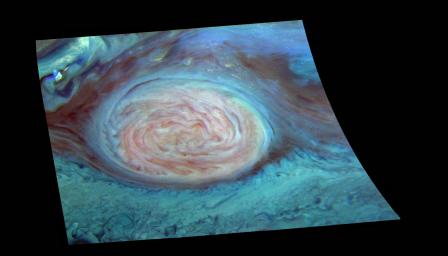
|
False Color Mosaic Great Red Spot
- Click the image above for a larger view
- Full-Res JPEG (2100 x 1200) (167.5 kB)
- Full-Res TIFF (2100 x 1200) (4.8 MB)
Caption:
False color representation of Jupiter's Great Red Spot (GRS) taken through three different near-infrared filters of the Galileo imaging system and processed to reveal cloud top height. Images taken through Galileo's near-infrared filters record sunlight beyond the visible range that penetrates to different depths in Jupiter's atmosphere before being reflected by clouds. The Great Red Spot appears pink and the surrounding region blue because of the particular color coding used in this representation. Light reflected by Jupiter at a wavelength (886 nm) where methane strongly absorbs is shown in red. Due to this absorption, only high clouds can reflect sunlight in this wavelength. Reflected light at a wavelength (732 nm) where methane absorbs less strongly is shown in green. Lower clouds can reflect sunlight in this wavelength. Reflected light at a wavelength (757 nm) where there are essentially no absorbers in the Jovian atmosphere is shown in blue: This light is reflected from the deepest clouds. Thus, the color of a cloud in this image indicates its height. Blue or black areas are deep clouds; pink areas are high, thin hazes; white areas are high, thick clouds. This image shows the Great Red Spot to be relatively high, as are some smaller clouds to the northeast and northwest that are surprisingly like towering thunderstorms found on Earth. The deepest clouds are in the collar surrounding the Great Red Spot, and also just to the northwest of the high (bright) cloud in the northwest corner of the image. Preliminary modeling shows these cloud heights vary over 30 km in altitude. This mosaic, of eighteen images (6 in each filter) taken over a 6 minute interval during the second GRS observing sequence on June 26, 1996, has been map-projected to a uniform grid of latitude and longitude. North is at the top.
Background Info:
Launched in October 1989, Galileo entered orbit around Jupiter on December 7, 1995. The spacecraft's mission is to conduct detailed studies of the giant planet, its largest moons and the Jovian magnetic environment. The Jet Propulsion Laboratory, Pasadena, CA manages the mission for NASA's Office of Space Science, Washington, DC.
This image and other images and data received from Galileo are posted on the World Wide Web, on the Galileo mission home page at http://galileo.jpl.nasa.gov. Background information and educational context for the images can be found at http://www.jpl.nasa.gov/galileo/sepo .
Cataloging Keywords:
| Name | Value | Additional Values |
|---|---|---|
| Target | Jupiter | |
| System | Jupiter | |
| Target Type | Planet | |
| Mission | Galileo | |
| Instrument Host | Galileo Orbiter | |
| Host Type | Orbiter | |
| Instrument | Solid-State Imaging (SSI) | |
| Detector | ||
| Extra Keywords | Atmosphere, Color, Haze, Infrared, Magnetosphere, Map, Methane, Storm | |
| Acquisition Date | ||
| Release Date | 1997-09-07 | |
| Date in Caption | 1996-06-26 | |
| Image Credit | NASA/JPL/Cornell University | |
| Source | photojournal.jpl.nasa.gov/catalog/PIA00489 | |
| Identifier | PIA00489 | |
